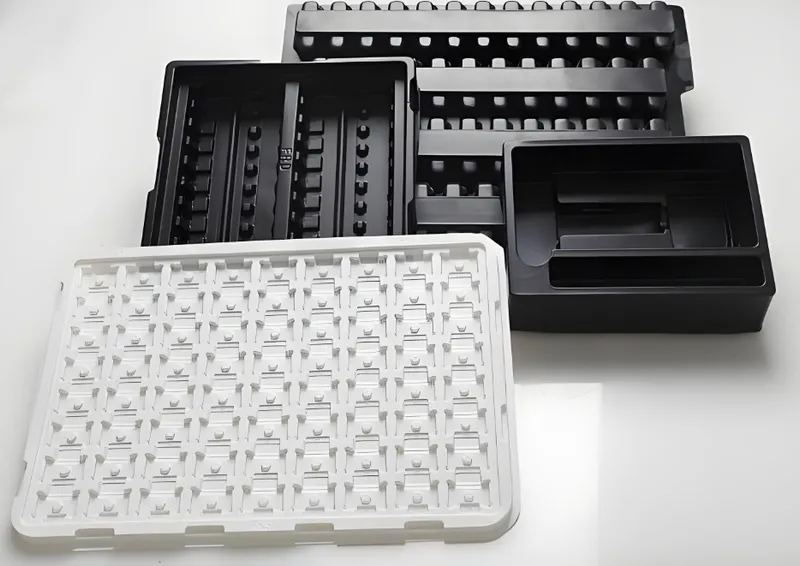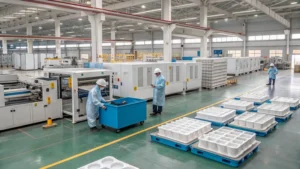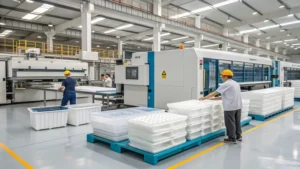
Cost control and budget management1 are pivotal for the success of thermoforming projects, a manufacturing process where plastic sheets are heated and molded into precise shapes for applications like packaging, automotive parts, and medical trays. Mastering these financial aspects ensures profitability while maintaining quality standards.
Cost control in thermoforming2 involves managing expenses across design, materials, tooling, and production to stay within budget, while budget management ensures funds are allocated efficiently across all project phases.
This blog delves into the strategies, challenges, and tools for effective cost control and budget management in thermoforming, offering actionable insights for industry professionals and decision-makers.
Cost control is essential for thermoforming project profitability.True
By managing expenses like materials and tooling, cost control ensures projects remain financially viable.
Budget management only focuses on the production phase.False
Budget management spans design, tooling, production, and post-processing for comprehensive financial oversight.
- 1. What is Cost Control in Thermoforming Projects?
- 2. What are the Key Strategies for Budget Management in Thermoforming?
- 3. How Does the Thermoforming Process Impact Costs?
- 4. What are the Best Practices for Cost Control in Thermoforming?
- 5. What are the Common Challenges in Budget Management for Thermoforming Projects?
- 6. How Does Thermoforming Compare to Other Manufacturing Processes in Terms of Cost?
- 7. What Tools Can Help with Cost Control in Thermoforming Projects?
- 8. Conclusion
What is Cost Control in Thermoforming Projects?
Cost control in thermoforming projects is the process of monitoring and managing expenses to prevent budget overruns. It encompasses costs related to materials, tooling, labor, and overhead, ensuring the project remains financially viable.

Cost control in thermoforming manages expenses across design, materials, tooling, and production to optimize resources and maintain profitability.
| Aspect | Description |
|---|---|
| Material Costs3 | Selecting cost-effective plastics like PP or PE for simple parts. |
| Tooling Costs4 | Using aluminum molds for lower initial costs than steel. |
| Labor Costs | Automating processes to minimize manual labor expenses. |
| Overhead Costs | Reducing energy consumption and waste to control operational costs. |
Material Selection
Material choice significantly impacts costs. Low-cost thermoplastics5 like polypropylene (PP) and polyethylene (PE) are ideal for simple applications such as food packaging due to their affordability and lower energy requirements for forming. Conversely, high-performance materials like polycarbonate (PC) or acrylonitrile butadiene styrene (ABS) are costlier but necessary for durable parts like automotive components, potentially reducing long-term maintenance expenses.

Tooling Design
Tooling is a major cost factor6. Opting for aluminum molds over steel reduces initial investments, especially for small to medium runs. Multi-part tools that produce several components at once further lower per-part tooling costs, enhancing cost efficiency.
Material selection directly impacts thermoforming project costs.True
Low-cost materials like PP reduce expenses, while high-performance options like PC increase costs but may offer durability benefits.
Tooling costs are negligible in thermoforming projects.False
Tooling can be a significant expense, manageable through cost-effective materials and designs.
What are the Key Strategies for Budget Management in Thermoforming?
Budget management involves planning and allocating funds across all thermoforming project phases—design, tooling, production, and post-processing—to ensure total expenditure aligns with the planned budget.
Budget management in thermoforming includes estimating costs for each phase and tracking expenses to prevent overspending.

Project Planning and Estimation
Effective budgeting starts with accurate cost estimation7:
-
Design Phase: Budget for CAD software, prototyping, and iterations.
-
Tooling Phase: Allocate funds for mold creation based on material and complexity.
-
Production Phase: Estimate material, labor, and machine costs by production volume.

- Post-Processing: Include trimming, finishing, and assembly expenses.
Monitoring and Control
Use project management tools8 to track expenses against the budget regularly. If costs exceed estimates, adjust by renegotiating supplier terms or optimizing production methods.
Budget management ensures financial oversight across all project phases.True
Planning and tracking expenses from design to post-processing prevents overspending.
Budget management is only necessary for large-scale projects.False
Even small projects benefit from budget management for cost efficiency and profitability.
How Does the Thermoforming Process Impact Costs?
The thermoforming process9—heating, forming, cooling, and trimming—directly influences project costs through material use, tooling, and production efficiency.
The thermoforming process involves heating and shaping plastic sheets, with costs driven by material choice, tooling design, and production volume.

Process Workflow Breakdown
-
Heating: Energy costs vary with material forming temperature.
-
Forming: Tooling design affects cycle times and labor expenses.
-
Cooling: Efficient cooling reduces cycle times, lowering costs.
-
Trimming: Automation cuts labor costs.
Production Volume
Higher volumes reduce per-part costs via economies of scale. For instance, producing 10,000 parts versus 1,000 spreads fixed costs like tooling over more units, decreasing the cost per part.
Higher production volumes always reduce per-part costs.True
Economies of scale lower per-part costs by distributing fixed expenses across more units.
The thermoforming process is always cheaper than injection molding.False
Thermoforming offers lower tooling costs, but injection molding may be more cost-effective for high volumes due to automation.
What are the Best Practices for Cost Control in Thermoforming?
Adopting best practices in design and process optimization can significantly reduce costs while maintaining quality.
Best practices for cost control10 include optimizing material use, designing efficient tools, minimizing waste, and automating processes.

Design for Cost Efficiency
-
Minimize Material Waste: Arrange parts to maximize sheet usage.
-
Simplify Geometry: Avoid complex shapes to reduce manufacturing costs.
-
Standardize Parts: Use standard sizes for tool reusability.
Process Optimization
-
Automate Trimming: Reduce labor costs with robotic systems.
-
Energy Efficiency: Optimize heating and cooling cycles.
-
Waste Minimization: Recycle scrap to lower material costs.
Automating processes always leads to cost savings.True
Automation reduces labor costs and boosts efficiency, cutting overall expenses.
Complex part designs have no impact on thermoforming costs.False
Complex designs increase tooling and production costs due to longer cycles and higher defect rates.
What are the Common Challenges in Budget Management for Thermoforming Projects?
Budget management faces challenges like material price volatility, design changes, and production delays11, which can disrupt financial plans.
Common challenges include material cost fluctuations12, unexpected design iterations, and production inefficiencies leading to budget overruns.

Material Price Fluctuations
Plastic prices can vary due to market trends, affecting budgets. Mitigate this with long-term supplier contracts or alternative materials.
Design Changes
Unplanned iterations increase costs. A thorough design review process can minimize changes post-start.
Production Delays
Delays raise labor and overhead costs. Regular monitoring and contingency plans help manage risks.
Material price fluctuations can significantly impact project budgets.True
Volatile costs can lead to unexpected expenses, complicating budget management.
Design changes rarely affect project costs.False
Iterations often require additional resources, increasing time and costs.
How Does Thermoforming Compare to Other Manufacturing Processes in Terms of Cost?
Thermoforming13 offers unique cost profiles compared to injection molding and blow molding, with advantages in specific scenarios.

Thermoforming has lower initial tooling costs than injection molding, ideal for small to medium runs, but may have higher per-part costs for large volumes.
| Process | Tooling Cost | Per-Part Cost (Low Volume) | Per-Part Cost (High Volume) |
|---|---|---|---|
| Thermoforming | Low | Moderate | High |
| Injection Molding | High | High | Low |
| Blow Molding | Moderate | Moderate | Moderate |
When to Choose Thermoforming
-
Small to Medium Runs: Low tooling costs suit prototyping and limited production.
-
Large, Simple Parts: Cost-effective for trays or panels with lower material costs.

When to Consider Alternatives
-
High-Volume Production: Injection molding offers lower per-part costs.
-
Hollow Parts: Blow molding suits bottles with balanced costs.
Thermoforming is the most cost-effective process for all production volumes.False
It excels in small to medium runs, but injection molding may be cheaper for high volumes.
Thermoforming offers flexibility in design changes at a low cost.True
Lower tooling costs allow easier, cheaper modifications than injection molding.
What Tools Can Help with Cost Control in Thermoforming Projects?
Practical tools like design checklists and decision frameworks enhance cost control and budget management.

Tools such as design checklists and process selection decision trees ensure cost-effective decisions throughout the project.
Design Checklist for Cost Control
| Aspect | Details |
|---|---|
| Minimize Material Waste | Fit multiple parts on sheets, avoid excess features. |
| Simplify Design | Reduce complexity, avoid undercuts. |
| Standardize Parts | Use standard sizes for tool reuse. |
| Multi-Part Tools | Design tools for simultaneous production of multiple parts. |
| Draft Angles | Use 2-5° angles for easy mold release. |
| Wall Thickness | Maintain uniformity for consistent strength. |
Process Selection Decision-Making
Consider these factors when choosing thermoforming:

-
Material: Assess cost and properties for plastic parts.
-
Production Volume: Ideal for 250-3000 parts annually.
-
Part Complexity: Best for simple to moderate shapes.
-
Cost vs. Precision: Lower precision but reduced tooling costs.
-
Budget Constraints: Ensure costs align with budget limits.
A design checklist can prevent costly mistakes in thermoforming projects.True
Checklists help avoid pitfalls that increase costs.
Thermoforming is always the best choice for plastic parts.False
It suits certain applications, but alternatives may be better for high-volume or complex parts.
Conclusion
Effective cost control and budget management are vital for thermoforming project success. By optimizing material selection, tooling design, and production processes, and using tools like design checklists, projects can achieve cost efficiency without sacrificing quality. Understanding thermoforming’s cost advantages over alternatives ensures informed decisions tailored to project needs.
Effective cost control and budget management are critical for thermoforming project success.True
Managing expenses and resources wisely ensures profitability.
Thermoforming is always the cheapest manufacturing process.False
It offers cost benefits in specific cases, but other processes may be more economical depending on volume and complexity.
-
Understanding budget management can significantly enhance project outcomes. This link will provide insights into efficient fund allocation and financial planning. ↩
-
Explore this resource to discover proven strategies that can help you manage costs effectively in thermoforming projects, ensuring profitability and efficiency. ↩
-
Understanding material costs is crucial for optimizing budget management in thermoforming. This link will provide valuable insights. ↩
-
Learn about the benefits of aluminum molds in reducing tooling costs and enhancing efficiency in thermoforming processes. ↩
-
Discover the benefits of low-cost thermoplastics for various applications, enhancing your material selection process. ↩
-
Understanding tooling costs can help you make informed decisions to optimize your thermoforming projects. ↩
-
This link will provide insights into enhancing cost estimation techniques, crucial for accurate budgeting in thermoforming. ↩
-
Discover top project management tools that can help streamline budget tracking and enhance financial oversight in manufacturing projects. ↩
-
Understanding the thermoforming process can help you optimize costs and improve production efficiency. ↩
-
Exploring cost control practices can lead to significant savings and improved project management. ↩
-
Exploring the effects of production delays can provide insights into risk management and cost control strategies. ↩
-
Understanding material cost fluctuations is crucial for effective budget management and can help you strategize better. ↩
-
Learning about Thermoforming's advantages can help you make informed decisions for your production needs. ↩








